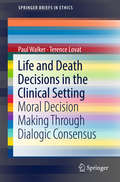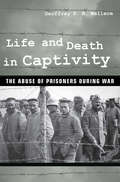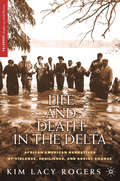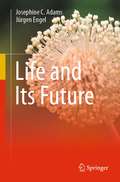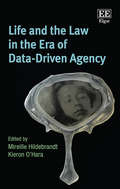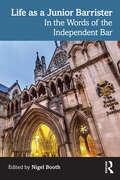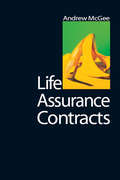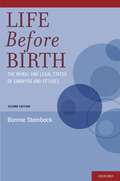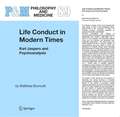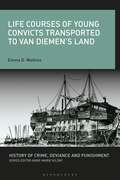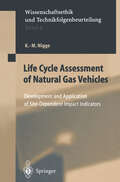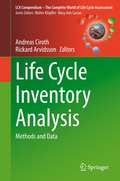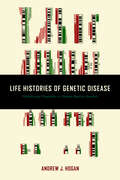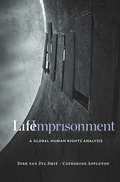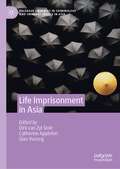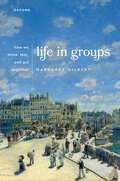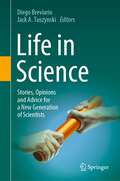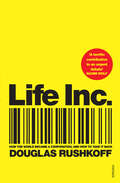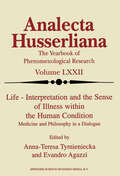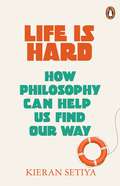- Table View
- List View
Life and Death Decisions in the Clinical Setting: Moral decision making through dialogic consensus (SpringerBriefs in Ethics)
by Paul Walker Terence LovatThis book moves away from the frameworks that have traditionally guided ethical decision-making in the Western clinical setting, towards an inclusive, non-coercive and, reflective dialogic approach to moral decision-making. Inspired in part by Jürgen Habermas’s discourse theory of morality and principles of communicative action, the book offers a proportionist approach as a way of balancing out the wisdom in traditional frameworks, set in the actual reality of the clinical situation at hand. Putting this approach into practice requires having a conversation, a dialogue or a discourse, with collaboration amongst all the stakeholders. The aim of the dialogue is to reach consensus in the decision, via mutual understanding of the values held by the patient and others whom they see as significant. This book aims to underscore the moral philosophical foundations for having a meaningful conversation. Life and Death Decision in the Clinical Setting is especially relevant in our contemporary era, characterised medically by an ever-increasing armamentarium of life-sustaining technology, but also by increasing multiculturalism, a multiplicity of faiths, and increasing value pluralism.
Life and Death in Captivity: The Abuse of Prisoners during War
by Geoffrey P. WallaceWhy are prisoners horribly abused in some wars but humanely cared for in others? In Life and Death in Captivity, Geoffrey P. R. Wallace explores the profound differences in the ways captives are treated during armed conflict. Wallace focuses on the dual role played by regime type and the nature of the conflict in determining whether captor states opt for brutality or mercy. Integrating original data on prisoner treatment during the last century of interstate warfare with in-depth historical cases, Wallace demonstrates how domestic constraints and external incentives shape the fate of captured enemy combatants. Both Russia and Japan, for example, treated prisoners very differently in the Russo-Japanese War of 1904–5 and in World War II; the behavior of any given country is liable to vary from conflict to conflict and even within the same war.Democracies may be more likely to treat their captives humanely, yet this benevolence is rooted less in liberal norms of nonviolence than in concerns over public accountability. When such concerns are weak or absent, democracies are equally capable of brutal conduct toward captives. In conflicts that devolve into protracted fighting, belligerents may inflict violence against captives as part of a strategy of exploitation and to coerce the adversary into submission. When territory is at stake, prisoners are further at risk of cruel treatment as their captors seek to permanently remove the most threatening sources of opposition within newly conquered lands. By combining a rigorous strategic approach with a wide-ranging body of evidence, Wallace offers a vital contribution to the study of political violence and wartime conduct.
Life and Death in the Delta: African American Narratives of Violence, Resilience, and Social Change (Palgrave Studies in Oral History)
by K. RogersTerrorism, black poverty, and economic exploitation produced a condition of collective trauma and social suffering for thousands of black Deltans in the Twentieth Century. Based on oral histories with African American activists and community leaders, this work reveals the impact of that oppression.
Life and Its Future
by Josephine C. Adams Jürgen EngelThis book is aimed at those who wish to understand more about the molecular basis of life and how life on earth may change in coming centuries. Readers of this book will gain knowledge of how life began on Earth, the natural processes that have led to the great diversity of biological organisms that exist today, recent research into the possibility of life on other planets, and how the future of life on earth faces unprecedented pressures from human-made activities. Readers will obtain a perspective on the potential risks of chemical or nuclear warfare, and the ever-increasing risks from human activities that are causing pollution and climate change with global heating. Readers will also learn about ongoing research efforts to generate “designer lifeforms” through synthetic biology and applications of artificial intelligence. The book makes an integrated, up-to-date, overview of topics often considered as separate fields. It should be valuable to students, teachers, and people who are concerned about the future of life.
Life and the Law in the Era of Data-Driven Agency
by Kieron O’Hara Mireille HildebrandtThis ground-breaking and timely book explores how big data, artificial intelligence and algorithms are creating new types of agency, and the impact that this is having on our lives and the rule of law. Addressing the issues in a thoughtful, cross-disciplinary manner, the authors examine the ways in which data-driven agency is transforming democratic practices and the meaning of individual choice. Leading scholars in law, philosophy, computer science and politics analyse the latest innovations in data science and machine learning, assessing the actual and potential implications of these technologies. They investigate how this affects our understanding of such concepts as agency, epistemology, justice, transparency and democracy, and advocate a precautionary approach that takes the effects of data-driven agency seriously without taking it for granted. Scholars and students of law, ethics and philosophy, in particular legal, political and democratic theory, will find this book a compelling and invaluable read, as will computer scientists interested in the implications of their own work. It will also prove insightful for academics and activists working on privacy, fairness and anti-discrimination.
Life as a Junior Barrister: In the Words of the Independent Bar
by Nigel BoothThis essential volume for all aspiring barristers offers guidance, insights and advice from new barristers from a diverse range of backgrounds and practice areas, shedding light on what life is really like for barristers at the independent Bar. Each chapter is candid and honest about the reality of the Bar and how it measures against student expectations. There is only one Bar, but working in different practice areas brings different challenges. This book brings together new practitioners from across the disciplines, from crime to commercial, from family to employment law, and more, as they each discuss their workloads, the sorts of cases and tasks that they typically face and highlight the skills which need to be developed in the first couple of years. Practical tips around time-management and finance feature, as well as advice around key social and cultural issues. The concluding chapter by Jaime Hamilton QC discusses the transformations that the Bar has undergone and continues to go through. Accessible and engaging, this invaluable resource is the perfect guide for anyone interested in exploring a career at the Bar. It will be an ideal companion to students of law at any level.
Life as a Junior Barrister: In the Words of the Independent Bar
by Nigel BoothThis essential volume for all aspiring barristers offers guidance, insights and advice from new barristers from a diverse range of backgrounds and practice areas, shedding light on what life is really like for barristers at the independent Bar. Each chapter is candid and honest about the reality of the Bar and how it measures against student expectations. There is only one Bar, but working in different practice areas brings different challenges. This book brings together new practitioners from across the disciplines, from crime to commercial, from family to employment law, and more, as they each discuss their workloads, the sorts of cases and tasks that they typically face and highlight the skills which need to be developed in the first couple of years. Practical tips around time-management and finance feature, as well as advice around key social and cultural issues. The concluding chapter by Jaime Hamilton QC discusses the transformations that the Bar has undergone and continues to go through. Accessible and engaging, this invaluable resource is the perfect guide for anyone interested in exploring a career at the Bar. It will be an ideal companion to students of law at any level.
Life Assurance Contracts
by Andrew McGeeLife assurance continues to be a topic of great practical significance, given the popularity of endowment mortgages and pensions, which contain an element of insurance, as well as the need for families to protect against the loss of their breadwinners. Since the first edition of this book in 1995 much has changed, with a fundamentally new regulatory structure under the Financial Services and Markets Act 2000, changes in divorce and bankruptcy law, as well as continued developments in areas such as insurable interest and utmost good faith. All these developments are covered in this new edition, which at the same time retains the extensive coverage of the well-established principles of this area of law. Areas dealt with include insurable interest, disclosure, cancellation, intermediaries, marketing, assignment, surrender and pension policies. This new edition has been comprehensively revised and updated to take account of changes since the last edition was published.
Life Assurance Contracts
by Andrew McGeeLife assurance continues to be a topic of great practical significance, given the popularity of endowment mortgages and pensions, which contain an element of insurance, as well as the need for families to protect against the loss of their breadwinners. Since the first edition of this book in 1995 much has changed, with a fundamentally new regulatory structure under the Financial Services and Markets Act 2000, changes in divorce and bankruptcy law, as well as continued developments in areas such as insurable interest and utmost good faith. All these developments are covered in this new edition, which at the same time retains the extensive coverage of the well-established principles of this area of law. Areas dealt with include insurable interest, disclosure, cancellation, intermediaries, marketing, assignment, surrender and pension policies. This new edition has been comprehensively revised and updated to take account of changes since the last edition was published.
Life Before Birth: The Moral and Legal Status of Embryos and Fetuses, Second Edition
by Bonnie SteinbockLife Before Birth provides a coherent framework for addressing bioethical issues in which the moral status of embryos and fetuses is relevant. It is based on the "interest view" which ascribes moral standing to beings with interests, and connects the possession of interests with the capacity for conscious awareness or sentience. The theoretical framework is applied to ethical and legal topics, including abortion, prenatal torts, wrongful life, the crime of feticide, substance abuse by pregnant women, compulsory cesareans, assisted reproduction, and stem cell research. Along the way, difficult philosophical problems, such as identity and the non-identity problem are thoroughly explored. The book will be of interest not only to philosophers, but also physicians, lawyers, policy makers, and anyone perplexed by the many difficulties surrounding the unborn. "Bonnie Steinbock's excellent book is . . . consistent, thoroughgoing, and intelligible." --Nature "Steinbock's book is valuable for all interested in the ethical/legal issues surrounding abortion, prenatal injury and liability, maternal-fetal conflict, and fetal/embryo research. The author provides an excellent historical overview of these issues, but she also addresses the issues from the stance of a particular theory of moral status, namely, interest theory. This gives coherence to her discussion as well as allowing testing of the viability of interest theory." --Choice "A focused, lucid, analytically fine-grained discussion of a wide variety of problems. . . extremely useful as a survey of the current state of the debate." --Religious Studies Review "Merits serious consideration by physicians. Steinbock's interests-based approach treats all questions as open -- another and most welcome breath of fresh air." -New England Journal of Medicine "An extremely valuable contribution to the literature. The author carefully identifies the many bioethical issues to which the status of embryos and fetuses is relevant....She thoroughly reviews the extensive medical, bioethical, and legal literature on all of these issues, offering well-developed critiques of many standard positions. She articulates and thoughtfully defends interesting positions on all of theses topics. Anyone with an interest in these issues will learn a great deal from her knowledgeable and judicious treatment of them." -- The Journal of Clinical Ethics
Life Conduct in Modern Times: Karl Jaspers and Psychoanalysis (Philosophy and Medicine #89)
by Matthias BormuthThis award-winning book investigates the critique of psychoanalysis formulated by the psychiatrist and philosopher Karl Jaspers (1883-1969) over some five decades, systematically examining Jasper’s arguments against Freud and his followers. The book traces the medico-historical roots of Jasper’s criticism of psychoanalysis and places it within the framework of scientific theory before devoting itself extensively to medico-ethical aspects of the controversy, which are ultimately treated in terms of a history of mentalities.
Life Courses of Young Convicts Transported to Van Diemen's Land (History of Crime, Deviance and Punishment)
by Emma D. WatkinsDrawing on digital criminal records, this book traces the life courses of young convicts who were sentenced at the Old Bailey and transported to Van Diemen's Land in the early 19th century. It explores the everyday lives of the convicts pre- and post-transportation, focusing on their crimes, punishments, education, employment and family life right up to their deaths. Emma D. Watkins contextualizes these young convicts within the punishment system, economy and culture that they were thrust into by their forced movement to Australia. This allows an understanding of the factors which determined their chances of achieving a 'settled life' away from crime in the colony.Packed with case studies offering vivid accounts of the offenders' lives, Life Courses of Young Convicts Transported to Van Diemen's Land makes an important contribution to the history of transportation, social history and Australian history.
Life Courses of Young Convicts Transported to Van Diemen's Land (History of Crime, Deviance and Punishment)
by Emma D. WatkinsDrawing on digital criminal records, this book traces the life courses of young convicts who were sentenced at the Old Bailey and transported to Van Diemen's Land in the early 19th century. It explores the everyday lives of the convicts pre- and post-transportation, focusing on their crimes, punishments, education, employment and family life right up to their deaths. Emma D. Watkins contextualizes these young convicts within the punishment system, economy and culture that they were thrust into by their forced movement to Australia. This allows an understanding of the factors which determined their chances of achieving a 'settled life' away from crime in the colony.Packed with case studies offering vivid accounts of the offenders' lives, Life Courses of Young Convicts Transported to Van Diemen's Land makes an important contribution to the history of transportation, social history and Australian history.
Life Cycle Assessment of Natural Gas Vehicles: Development and Application of Site-Dependent Impact Indicators (Ethics of Science and Technology Assessment #6)
by K.-M. NiggeIn the context of conducting research on the consequences of scientific and tech nological advance, the Europaische Akademie is also concerned with the support of scientists in the doctoral or post-doctoral phase who are working on topics or methods within its research spectrum. The first dissertation supported by the Europaische Akademie is published in this volume of the book series "Wissen schaftsethik und Technikfolgenbeurteilung". One of the research areas of the Europaische Akademie is the scientific investi gation of environmental consequences of new technologies. Energy conversion and transportation are thereby considered as important areas of technological advance. The dissertation follows this thread by comparing the impacts of natural gas vehicles on human health and the environment with those of reference vehi cles fueled by petrol and Diesel. This question is addressed within the framework of Life Cycle Assessment, which is one important instrument of environmental Technology Assessment. Within this framework, a new method for the assessment of impacts on human health is developed and applied. In this way, the dissertation contributes to the methodological research of the Europaische Akademie in the field of Technology Assessment. The book is addressed to researchers in the fields of alternative fuels, Techno logy Assessment, and Life Cycle Assessment in particular. It may also be of inter est to decisionmakers and the wider public concerned with environmental impacts of energy conversion and transportation. It was written in English in order to be accessible to an international audience.
Life Cycle Inventory Analysis: Methods and Data (LCA Compendium – The Complete World of Life Cycle Assessment)
by Andreas Ciroth Rickard ArvidssonLife Cycle Inventory (LCI) Analysis is the second phase in the Life Cycle Assessment (LCA) framework. Since the first attempts to formalize life cycle assessment in the early 1970, life cycle inventory analysis has been a central part. Chapter 1 “Introduction to Life Cycle Inventory Analysis“ discusses the history of inventory analysis from the 1970s through SETAC and the ISO standard. In Chapter 2 “Principles of Life Cycle Inventory Modeling”, the general principles of setting up an LCI model and LCI analysis are described by introducing the core LCI model and extensions that allow addressing reality better. Chapter 3 “Development of Unit Process Datasets” shows that developing unit processes of high quality and transparency is not a trivial task, but is crucial for high-quality LCA studies. Chapter 4 “Multi-functionality in Life Cycle Inventory Analysis: Approaches and Solutions” describes how multi-functional processes can be identified. In Chapter 5 “Data Quality in Life Cycle Inventories”, the quality of data gathered and used in LCI analysis is discussed. State-of-the-art indicators to assess data quality in LCA are described and the fitness for purpose concept is introduced. Chapter 6 “Life Cycle Inventory Data and Databases“ follows up on the topic of LCI data and provides a state-of-the-art description of LCI databases. It describes differences between foreground and background data, recommendations for starting a database, data exchange and quality assurance concepts for databases, as well as the scientific basis of LCI databases. Chapter 7 “Algorithms of Life Cycle Inventory Analysis“ provides the mathematical models underpinning the LCI. Since Heijungs and Suh (2002), this is the first time that this aspect of LCA has been fundamentally presented. In Chapter 8 “Inventory Indicators in Life Cycle Assessment”, the use of LCI data to create aggregated environmental and resource indicators is described. Such indicators include the cumulative energy demand and various water use indicators. Chapter 9 “The Link Between Life Cycle Inventory Analysis and Life Cycle Impact Assessment” uses four examples to discuss the link between LCI analysis and LCIA. A clear and relevant link between these phases is crucial.
Life Histories of Genetic Disease: Patterns and Prevention in Postwar Medical Genetics
by Andrew J. HoganMedical geneticists began mapping the chromosomal infrastructure piece by piece in the 1970s by focusing on what was known about individual genetic disorders. Five decades later, their infrastructure had become an edifice for prevention, allowing today;€™s expecting parents to choose to test prenatally for hundreds of disease-specific mutations using powerful genetic testing platforms. In Life Histories of Genetic Disease, Andrew J. Hogan explores how various diseases were "made genetic" after 1960, with the long-term aim of treating and curing them using gene therapy. In the process, he explains, these disorders were located in the human genome and became targets for prenatal prevention, while the ongoing promise of gene therapy remained on the distant horizon.In narrating the history of research that contributed to diagnostic genetic medicine, Hogan describes the expanding scope of prenatal diagnosis and prevention. He draws on case studies of Prader-Willi, fragile X, DiGeorge, and velo-cardio-facial syndromes to illustrate that almost all testing in medical genetics is inseparable from the larger;¢;‚¬;€?and increasingly "big data";€“oriented;¢;‚¬;€?aims of biomedical research. Hogan also reveals how contemporary genetic testing infrastructure reflects an intense collaboration among cytogeneticists, molecular biologists, and doctors specializing in human malformation.Hogan critiques the modern ideology of genetic prevention, which suggests that all pregnancies are at risk for genetic disease and should be subject to extensive genomic screening. He examines the dilemmas and ethics of the use of prenatal diagnostic information in an era when medical geneticists and biotechnology companies have begun offering whole genome prenatal screening;¢;‚¬;€?essentially searching for any disease-causing mutation. Hogan;€™s focus and analysis is animated by ongoing scientific and scholarly debates about the extent to which the preventive focus in contemporary medical genetics resembles the aims of earlier eugenicists. Written for historians, sociologists, and anthropologists of science and medicine, as well as bioethics scholars, physicians, geneticists, and families affected by genetic conditions, Life Histories of Genetic Disease is a profound exploration of the scientific culture surrounding malformation and mutation.
Life Histories of Genetic Disease: Patterns and Prevention in Postwar Medical Genetics
by Andrew J. HoganMedical geneticists began mapping the chromosomal infrastructure piece by piece in the 1970s by focusing on what was known about individual genetic disorders. Five decades later, their infrastructure had become an edifice for prevention, allowing today;€™s expecting parents to choose to test prenatally for hundreds of disease-specific mutations using powerful genetic testing platforms. In Life Histories of Genetic Disease, Andrew J. Hogan explores how various diseases were "made genetic" after 1960, with the long-term aim of treating and curing them using gene therapy. In the process, he explains, these disorders were located in the human genome and became targets for prenatal prevention, while the ongoing promise of gene therapy remained on the distant horizon.In narrating the history of research that contributed to diagnostic genetic medicine, Hogan describes the expanding scope of prenatal diagnosis and prevention. He draws on case studies of Prader-Willi, fragile X, DiGeorge, and velo-cardio-facial syndromes to illustrate that almost all testing in medical genetics is inseparable from the larger;¢;‚¬;€?and increasingly "big data";€“oriented;¢;‚¬;€?aims of biomedical research. Hogan also reveals how contemporary genetic testing infrastructure reflects an intense collaboration among cytogeneticists, molecular biologists, and doctors specializing in human malformation.Hogan critiques the modern ideology of genetic prevention, which suggests that all pregnancies are at risk for genetic disease and should be subject to extensive genomic screening. He examines the dilemmas and ethics of the use of prenatal diagnostic information in an era when medical geneticists and biotechnology companies have begun offering whole genome prenatal screening;¢;‚¬;€?essentially searching for any disease-causing mutation. Hogan;€™s focus and analysis is animated by ongoing scientific and scholarly debates about the extent to which the preventive focus in contemporary medical genetics resembles the aims of earlier eugenicists. Written for historians, sociologists, and anthropologists of science and medicine, as well as bioethics scholars, physicians, geneticists, and families affected by genetic conditions, Life Histories of Genetic Disease is a profound exploration of the scientific culture surrounding malformation and mutation.
Life Imprisonment: A Global Human Rights Analysis (Oñati International Series In Law And Society Ser.)
by Dirk van Zyl SmitLife imprisonment has replaced the death penalty as the most common sentence imposed for heinous crimes worldwide. Consequently, it has become the leading issue of international criminal justice reform. In the first survey of its kind, Dirk van Zyl Smit and Catherine Appleton argue for a human rights–based reappraisal of this harsh punishment.
Life Imprisonment in Asia (Palgrave Advances in Criminology and Criminal Justice in Asia)
by Dirk van Zyl Smit Catherine Appleton Giao VucongLife imprisonment is the punishment most often imposed worldwide for what societies regard as the most serious offences. Yet, in Asia the phenomenon has never been studied systematically. Life Imprisonment in Asia fills this major gap. It brings together thirteen new essays on life imprisonment in key jurisdictions in the region. Each chapter consolidates what is known about the law and practice of life imprisonment in the jurisdiction and then explores aspects of the imposition or implementation of life sentences that the authors regard as particularly problematic. In some instances, the main issue is the imposition of life sentences by the courts and their relationship to the death penalty. In others, the focus is on the treatment of life sentenced prisoners. In many instances, the most prominent question is whether life sentenced prisoners should be released and, if so, according to what processes. In the overview chapter, the editors place the complex picture that emerges of life imprisonment in Asia in a global context and point to reforms urgently required to ensure that Asian life sentences meet international human rights standards.Life Imprisonment in Asia should be read by everyone who has an interest in just punishments for serious offences, not only in Asia, but throughout the world. It will be an invaluable tool for lawyers, criminologists, policy makers and penal reform advocates in the region and beyond.
Life in Groups: How We Think, Feel, and Act Together
by Margaret GilbertLife in Groups: How We Think, Feel, and Act Together develops and applies the author's perspective on topics she relates to joint commitment. This kind of commitment unifies those who participate in it, guides their actions going forward, and determines their relations to one another in important ways. In particular, it grounds in each of the parties a set of rights and obligations of a central kind. This volume contains thirteen essays, together with a substantial introduction, which serves both to explain joint commitment for those unfamiliar with it and to advance discussion in light of some questions it has prompted, and a reflective conclusion. The essays range over collective beliefs and intentions; rational choice and collective preference; group lies and corporate misbehavior; remorse and other emotions in a group context; rights, obligations, and freedom.
Life in Groups: How We Think, Feel, and Act Together
by Margaret GilbertLife in Groups: How We Think, Feel, and Act Together develops and applies the author's perspective on topics she relates to joint commitment. This kind of commitment unifies those who participate in it, guides their actions going forward, and determines their relations to one another in important ways. In particular, it grounds in each of the parties a set of rights and obligations of a central kind. This volume contains thirteen essays, together with a substantial introduction, which serves both to explain joint commitment for those unfamiliar with it and to advance discussion in light of some questions it has prompted, and a reflective conclusion. The essays range over collective beliefs and intentions; rational choice and collective preference; group lies and corporate misbehavior; remorse and other emotions in a group context; rights, obligations, and freedom.
Life in Science: Stories, Opinions and Advice for a New Generation of Scientists
by Diego Breviario Jack A. TuszynskiThis book is a collection of stories, reflections and advice written by proficient scientists. They address the question of what doing science means to them, and describe attitudes and working practices that have proved effective and rewarding. The book is aimed in particular at young people who are attracted by science or already undertaking undergraduate studies, and who are considering making science their long-term profession. It will also be helpful and revealing to early-career scientists who are searching for their own best route to success. The book serves as a platform for experienced scientists to describe their original inclination, how that subjective disposition found its expression in their way of doing science, whether their expectations were met, and what achievements they can claim. But it is not restricted to success: contributors also share details of the limitations and failures they have encountered. Last but not least they describe how they see science now, how they think it will be in the near future, and what advice they would give to the their much younger colleagues. Readers will appreciate the diversity of the individual paths shaped by different education, motivation, ambition, inclination, intuition, feeling, belief and eligibility. At the same time the stories confirm that science relies on a translation of this subjective level into an objective level, one that is shared and accepted by the international scientific community, and whose results are produced with a commonly accepted and fully rational scientific method of investigation.
Life Inc: How the World Became a Corporation and How to Take it Back
by Douglas RushkoffDouglas Rushkoff was mugged outside his apartment on Christmas Eve, but when he posted a friendly warning on his community website, the responses castigated him for potentially harming the local real-estate market. When did these corporate values overtake civic responsibilites? Rushkoff examines how corporatism has become an intrinsic part of our everyday lives, choices and opinions. He demonstrates how this system created a world where everything can be commodified, where communities have dissolved into consumer groups, where fiction and reality have become fundamentally blurred. And, with this system on the verge of collapse, Rushkoff shows how the simple pleasures that make us human can also point the way to freedom.
Life Interpretation and the Sense of Illness within the Human Condition: Medicine and Philosophy in a Dialogue (Analecta Husserliana #72)
by Anna-Teresa Tymieniecka E. AgazziIn medicine the understanding and interpretation of the complex reality of illness currently refers either to an organismic approach that focuses on the physical or to a 'holistic' approach that takes into account the patient's human sociocultural involvement. Yet as the papers of this collection show, the suffering human person refers ultimately to his/her existential sphere. Hence, praxis is supplemented by still other perspectives for valuation and interpretation: ethical, spiritual, and religious. Can medicine ignore these considerations or push them to the side as being subjective and arbitrary? Phenomenology/philosophy-of-life recognizes all of the above approaches to be essential facets of the Human Condition (Tymieniecka). This approach holds that all the facets of the Human Condition have equal objectivity and legitimacy. It completes the accepted medical outlook and points the way toward a new `medical humanism'.
Life Is Hard: How Philosophy Can Help Us Find Our Way
by Kieran SetiyaA NEW YORKER AND THE ECONOMIST BEST BOOK OF 2022"Life Is Hard is a humane consolation for challenging times. Reading it is like speaking with a thoughtful friend who never tells you to cheer up, but, by offering gentle companionship and a change of perspective, makes you feel better anyway" The New York Times Book Review'An eloquent, moving, witty and above all useful demonstration of philosophy's power to help us weather the storms of being human' Oliver Burkeman, author of FOUR THOUSAND WEEKS______________________________________Pain, Loneliness, Grief, Injustice ... Hope?Life is hard - as the past few years have made painfully clear. From personal trauma to the injustice and absurdity of the world, sometimes simply going on can feel too much.But could there be solace - and even hope - in acknowledging the hardships of the human condition? Might doing so free us from the tyranny of striving for our "best lives" and help us find warmth, humanity, and humour in the lives we actually have? Could it inspire in us the desire for a better world?In this profound and personal book, Kieran Setiya shows how philosophy can help us find our way. He shares his own experience with chronic pain and the consolation that comes from making sense of it. He asks what we can learn from loneliness and loss about the value of human life. And he explores how we can fail with grace, confront injustice, and search for meaning in the face of despair. Drawing on ancient and modern philosophy, as well as fiction, comedy, social science and personal essay, Life is Hard is a book for this moment - a work of solace and compassion. It draws us towards justice, for ourselves and others, by acknowledging what it means to be alive.
